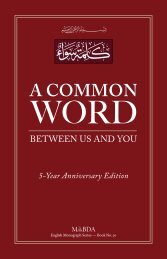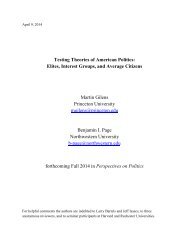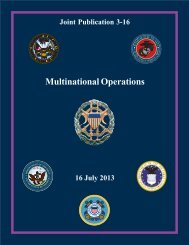ABUSE OF STRUCTURED FINANCIAL PRODUCTS- Misusing Basket Options to Avoid Taxes and Leverage Limits MAJORITY AND MINORITY STAFF REPORT
ABUSE OF STRUCTURED FINANCIAL PRODUCTS- Misusing Basket Options to Avoid Taxes and Leverage Limits MAJORITY AND MINORITY STAFF REPORT
ABUSE OF STRUCTURED FINANCIAL PRODUCTS- Misusing Basket Options to Avoid Taxes and Leverage Limits MAJORITY AND MINORITY STAFF REPORT
Create successful ePaper yourself
Turn your PDF publications into a flip-book with our unique Google optimized e-Paper software.
<strong>ABUSE</strong> <strong>OF</strong> <strong>STRUCTURED</strong> <strong>FINANCIAL</strong> <strong>PRODUCTS</strong>:<br />
<strong>Misusing</strong> <strong>Basket</strong> <strong>Options</strong> <strong>to</strong> <strong>Avoid</strong> <strong>Taxes</strong> <strong>and</strong> <strong>Leverage</strong> <strong>Limits</strong><br />
I. EXECUTIVE SUMMARY<br />
For the last decade, the U.S. Senate Permanent Subcommittee on Investigations has<br />
presented case his<strong>to</strong>ries showing how financial institutions, law firms, accountants, <strong>and</strong> others<br />
have designed <strong>and</strong> implemented complex financial structures <strong>to</strong> take advantage of <strong>and</strong>, at times,<br />
abuse or violate U.S. tax statutes, securities regulations, <strong>and</strong> accounting rules. 1 This<br />
investigation offers yet another detailed case study of how two financial institutions – Deutsche<br />
Bank AG <strong>and</strong> Barclays Bank PLC – developed structured financial products called MAPS <strong>and</strong><br />
COLT, two types of basket options, <strong>and</strong> sold them <strong>to</strong> one or more hedge funds, including<br />
Renaissance Technologies LLC <strong>and</strong> George Weiss Associates, that used them <strong>to</strong> avoid federal<br />
taxes <strong>and</strong> leverage limits on buying securities with borrowed funds. While that type of option<br />
product was identified as abusive in a public memor<strong>and</strong>um by the Internal Revenue Service<br />
(IRS) in 2010, taxes have yet <strong>to</strong> be collected on many of the basket option transactions <strong>and</strong> its<br />
use <strong>to</strong> circumvent federal leverage limits has yet <strong>to</strong> be analyzed or halted.<br />
The basket option contracts examined by the Subcommittee investigation were used by at<br />
least 13 hedge funds <strong>to</strong> conduct over $100 billion in securities trades, most of which were shortterm<br />
transactions <strong>and</strong> some of which lasted only seconds. Yet the resulting short-term profits<br />
were frequently cast as long-term capital gains subject <strong>to</strong> a 20% tax rate (previously 15%) rather<br />
than the ordinary income tax rate (currently as high as 39%) that would otherwise apply <strong>to</strong><br />
inves<strong>to</strong>rs in hedge funds engaged in daily trading. While the banks styled the trading<br />
arrangement as an “option” under which profits from short-term trades would be treated as long<br />
term capital gains, in essence, the banks loaned the hedge funds money <strong>to</strong> finance their trading<br />
<strong>and</strong> allowed them <strong>to</strong> trade for themselves in highly leveraged positions in the banks’ proprietary<br />
accounts <strong>and</strong> reap the resulting profits. The banks offering the “options” benefited from the<br />
financing, trading, <strong>and</strong> other fees charged <strong>to</strong> the hedge funds initiating the trades. In the end, the<br />
trading conducted by the hedge funds using the basket option accounts was virtually<br />
indistinguishable from the trading conducted by hedge funds using their own brokerage<br />
accounts, <strong>and</strong> provided no justification for treating the resulting short-term trading profits as<br />
long-term capital gains.<br />
The facts indicate that the basket option structures examined in this investigation were<br />
devised by sophisticated financial firms <strong>to</strong> allow clients <strong>to</strong> circumvent federal taxes <strong>and</strong> leverage<br />
limits. The structures rested on two fictions. The first was that the bank, rather than the hedge<br />
fund, owned the assets being traded in the designated option accounts, even though the hedge<br />
fund bought <strong>and</strong> sold the assets, was exposed <strong>to</strong> all significant risks <strong>and</strong> rewards, <strong>and</strong> profited<br />
1 See, e.g., U.S. Senate Permanent Subcommittee on Investigations reports <strong>and</strong> hearings, “Fishtail, Bacchus,<br />
Sundance, <strong>and</strong> Slapshot: Four Enron Transactions Funded <strong>and</strong> Facilitated by U.S. Financial Institutions,” S. Prt.<br />
107-82 (1/2/2003); “U.S. Tax Shelter Industry: The Role of Accountants, Lawyers, <strong>and</strong> Financial Professionals,” S.<br />
Hrg. 108-473 (11/18 <strong>and</strong> 20/2003); “Tax Haven Abuses: The Enablers, The Tools <strong>and</strong> Secrecy,” S. Hrg 109-797<br />
(8/1/2006); “Repatriating Offshore Funds: 2004 Tax Windfall for Select Multinationals,” S. Prt. 112-27<br />
(10/11/2011); “Offshore Profit Shifting <strong>and</strong> the U.S. Tax Code – Part 1 (Microsoft <strong>and</strong> Hewlett-Packard),” S. Hrg.<br />
112-781 (9/20/2012); <strong>and</strong> “Offshore Profit Shifting <strong>and</strong> the U.S. Tax Code - Part 2 (Apple Inc.),” S. Hrg. 113-90<br />
(5/13/2013).







